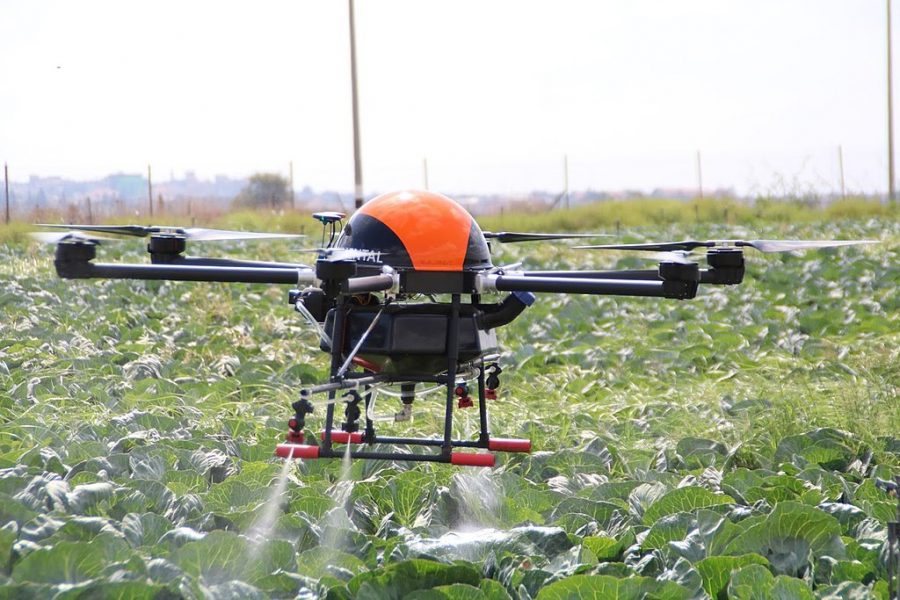
MGNREGA fallout: Farmers turn to drones in TN to spray pesticides

The Delta districts namely Thanjavur, Tiruvarur, Mayiladuthurai and Nagapattinam in Tamil Nadu, are now in the thick of the Samba and Thaladi season and actively engaged in paddy cultivation. While Samba crops will be harvested in the first week of January 2022 nearing the Pongal festival, Thaladi crops will be reaped after Pongal.
The region has already received abundant rain and the northeast monsoon rains too are expected from October 26. Farming activities are on in full swing in these districts which are famously known as the ‘rice bowls of the state’.
Farmers are however currently tussling with a significant shortage of labourers to spray pesticides. The reason for the labour shortage is largely the fallout of the MGNREGA scheme, under which the villagers get a guaranteed wage employment for 100 days. Of late, this scheme has been attacked by many political parties such as Seeman’s Naam Tamilar Katchi.
A substitute for labourers
In this situation, drones or Unmanned Aerial Vehicles have emerged as an useful substitute for labourers. A few progressive farmers across the state have already started deploying drones to spray pesticides and they it find it faster, cheaper and more effective.
Arivazhagan, a farmer based in Thanjavur, owns 40 acres of land on which he cultivates paddy. Earlier, he manually sprayed pesticides taking 10 tanks to cover one acre. (The capacity of one tank is 13 litres of pesticide). “A labourer, who is paid ₹600 per day, covers a maximum of three acres in a day. But today, we are finding it difficult to engage labour since many find it difficult to carry the spray equipment and wade through the farm filled with water and mud,” said Arivazhagan.
Also read: AIADMK@50: The political party MGR built battles for survival
There are many advantages with drones, added the farmer. “Drones are able to complete the spraying in a matter of four to five hours using up just one tank to cover an acre. Also, the crops seem to absorb the pesticide almost to a 95 per cent level,” pointed out Arivazhagan. Besides they pay ₹425 for the usage of drones.
Chinnasamy, another farmer from Salem district, cultivates maize in his two and a half acres of land.
According to Chinnasamy, he forks out ₹500 to get a labourer to spray 10 tanks of pesticide. But he may have to pay the labourer an additional ₹200 to fetch the water to mix with the pesticide. Also, Chinnasamy felt that the labourers find it difficult to spray pesticide on maize crops that tend to grow tall and tower over them.
“Before the MGNREGA scheme, we had people who used to come forward to do this job. But now, they find it is too difficult,” said Chinnasamy.
Chinnasamy too felt drones are more viable. Farmers are able to use one tank to cover 10 acres by using drones, while if it is done manually more pesticide tanks are required. He cited the example of the pesticide brand Delegate, which costs ₹1,000 for a 100 ml bottle.
He explained, “When we spray manually through sprayers, we have to use 10 ml per tank. To cover one acre, we need to use 10 tanks and for 10 acres we need 10 bottles. This costs us ₹10,000 but when we use drones we need just one tank to cover 10 acres. Instead of spending ₹10,000, now, I need to spend only ₹1,000. Besides, when spraying by drones, the pesticide is absorbed by the roots of the crop and hence the yield is also good.”
Pesticide spraying through drones is more effective as well, added Chinnasamy.
These drones are developed by the Centre for Aerospace Research, Madras Institute of Technology, which has more than 20 years of experience in UAV research. The institute is collaborating with the government and offer drone services. Currently, 40 drones are being used for agricultural activities.
Also read: `As LPG prices soar, residents of Delhi, TN, Telangana switch to electric
“The farmers who like to use drones will contact us and we provide the service. By word of mouth, the effectiveness of drone usage spreads among other farmers in the areas as well and they get in touch, ” said Nathan, who pilots the drones.
‘Usage of drones will address unemployment’
Talking to The Federal, Prof K Senthilkumar, director, Centre for Aerospace Research, MIT said that the usage of drones will address unemployment.
The director pointed out, “In Tamil Nadu, there are nearly 13,000 villages. One drone costs about ₹50,000. If ₹60 crores to ₹70 crores is budgeted for this, all villages can have a drone. A drone unit can have 10 members who can operate and maintain the drones. Even a person who completed the ITI course can be employed with a salary of ₹30,000 per month. In this way, the usage of drones can address unemployment.”
The state is expected to shortly launch a Drone Corporation. The Tamil Nadu Aerospace and Defence Policy too has given a thrust to drones by setting up a drone testing facility.
Senthilkumar said that by 2030, drones sector will contribute about $20 billion dollars to the economy. “Keeping that in mind, the Union government has recently approved Product Linked Incentive (PLI) to drone manufacturers. Under PLI, drone manufacturers will be given 20 per cent incentive for any value addition,” he added.


